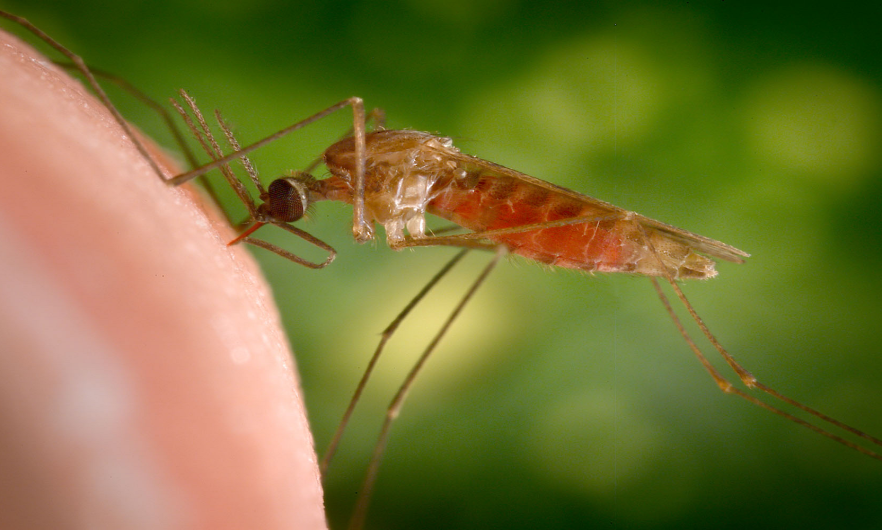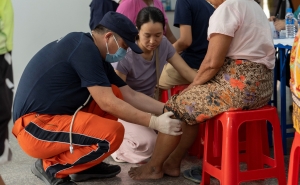Johns Hopkins Study Supports Potential for Injectable ‘Chemical Vaccine’ For Malaria Using Atovaquone
Researchers demonstrate in mouse model that key mutation that renders malaria parasites resistant to atovaquone also makes them non-transmissible via mosquitoes.

Photo credit: James Gathany/CDC
Johns Hopkins researchers looking to develop a long-acting, injectable malaria preventive using atovaquone have shown in a new study that resistance may not be the challenge scientists thought it was, particularly when using atovaquone as a malaria preventive. Malaria parasites in infected patients being treated with atovaquone tend to develop a resistance to the drug. Because of this, atovaquone by itself is not used as a malaria treatment nor has not been seen as a strong candidate for use as a preventive.
The study, led by a team of researchers at the Johns Hopkins Malaria Research Institute and the Johns Hopkins University School of Medicine, in conjunction with colleagues at the University of Liverpool, was published online October 12 in Nature Communications. The Malaria Research Institute is based at the Johns Hopkins Bloomberg School of Public Health.
In their study, the researchers found that the same genetic mutation that renders malaria parasites resistant to atovaquone in patients also destroys the parasite’s ability to live within mosquito hosts—meaning atovaquone-resistant malaria parasites would not be transmissible. The researchers concluded that atovaquone, despite concerns over resistance, holds promise as a long-acting, injectable “chemical vaccine” that could prevent infection in malaria-endemic areas.
“These findings should reduce concerns about the transmission of atovaquone resistance with atovaquone therapy, particularly when it is used as a chemical vaccine,” says study senior author Theresa Shapiro, MD, PhD, professor of Clinical Pharmacology in the Johns Hopkins University School of Medicine and professor in the W. Harry Feinstone Department of Molecular Microbiology and Immunology at the Bloomberg School.
Malaria continues to be a major global health burden. According to the World Health Organization, the mosquito-borne parasitic disease afflicted nearly a quarter of a billion people in 2021, killing more than 600,000. Researchers generally agree that, despite the impact of insecticides and other malaria control measures, and the recent development of a malaria vaccine, new approaches against this deadly parasitic pathogen are needed.
One new approach, described by Shapiro and colleagues at the University of Liverpool in a 2018 preclinical study, would use an injectable, slow-release formulation of atovaquone to provide vaccine-like protection for weeks at a time. Atovaquone is generally considered safe for long-term use even at higher doses, and has the further advantage that it interrupts the malaria life-cycle in human hosts even at the pre-symptomatic stage, when the parasite is developing in liver cells.
However, when atovaquone is used not as a preventive but as a treatment for symptomatic malaria infection, it often fails due to the emergence of genetically acquired resistance. Shapiro notes that by the time an infection is symptomatic, it involves billions of individual malaria organisms, and in this vast population it is likely that a resistance mutation will appear, if only by random genetic variation. Under atovaquone treatment, parasites with this mutation will come to dominate the infection. Because of the resistance problem, atovaquone is used to treat malaria only in combination with another antimalarial called proguanil.
Resistance should be much less likely when using atovaquone as a preventive in people who are malaria-free, Shapiro says. The drug in such cases would be acting against a far smaller number of individual parasites that are only in the early, liver-infection stage.
“In fact, there are no reported cases of atovaquone resistance when the drug has been given prophylactically,” she says.
Nevertheless, fear of resistance has left a cloud over the drug’s use even as a preventive. Indeed, there have been concerns that the mutation, once it emerged—for example, in a large population treated prophylactically with atovaquone—could spread via human-to-mosquito-to-human transmission.
In the study, Shapiro’s team examined the resistance problem, focusing on a key resistance mutation, cytochrome-b Y268S, that has been found in clinical investigations involving the major malaria parasite of concern, Plasmodium falciparum. The researchers confirmed that P. falciparum parasites carrying this mutation are thousands of times less susceptible to atovaquone, compared to unmutated parasites.
However, the scientists also found that the Y268S mutation, while it enables P. falciparum to survive in human hosts being treated with atovaquone, essentially destroys its ability to live within its Anopheles mosquito hosts. This means that atovaquone-resistant mutant parasites cannot spread via transmission from humans to mosquitoes and back again—as the researchers demonstrated using mosquitoes and a P. falciparum-infectable mouse model. For the study, the mice were engrafted with human liver cells and human red blood cells.
“Testing the mutant parasites for their ability to infect humanized mice is the best in vivo assay we have short of using humans, and strongly supports the inability of drug-resistant parasites to be transmitted by mosquitoes,” says Photini Sinnis, MD, deputy director at the Johns Hopkins Malaria Research Institute and one of the paper’s senior authors.
The findings suggest that a “chemical vaccine” strategy for protecting people from malaria with atovaquone remains viable and should continue to be investigated. Shapiro and colleagues are collaborating with Andrew Owen, PhD, a professor at the University of Liverpool, and his team to complete preclinical studies and launch a Phase I trial. Owen is principal investigator for LONGEVITY, an international project funded by Unitaid that aims to translate long-acting medicines for malaria and other diseases that disproportionately affect people in low- and middle-income countries.
“Many advances in malaria medicines that have started at small scale for the protection of travelers, later see wider use in endemic areas where they are most needed—and this may be the path atovaquone takes as a chemical vaccine,” Shapiro says.
The study’s first author was Victoria Balta, PhD, a graduate student working with coauthor David Sullivan, MD, a professor in the Bloomberg School’s Department of Molecular Microbiology and Immunology.
“Clinically relevant atovaquone-resistant human malaria parasites fail to transmit by mosquito” was co-authored by Victoria A. Balta, Deborah Stiffler, Abeer Sayeed, Abhai Tripathi, Rubayet Elahi, Godfree Mlambo, Rahul Bakshi, Amanda Dziedzic, Anne Jedlicka, Elizabeth Nenortas, Keyla Romero-Rodriguez, Matthew Canonizado, Alexis Mann, Andrew Owen, David Sullivan, Sean Prigge, Photini Sinnis and Theresa Shapiro.
Funding was provided by Unitaid (2020-38-LONGEVITY); the Johns Hopkins Malaria Research Institute and Bloomberg Philanthropies; and the National Institutes of Health (R01AI132359, R01AI1095453, T32AI138953).
Disclosures
Johns Hopkins co-authors Rahul P. Bakshi, Godfree Mlambo, Theresa A. Shapiro, Abhai K. Tripathi, and co-author Andrew Owen of the University of Liverpool, are co-inventors on PCT/GB2017/ 051746 (Atovaquone long-acting injectable formulation).
Additional author disclosures appear in the Competing interests section at the end of the paper, which is open access.
# # #
Media contacts: Ana Coyne acoyne4@jh.edu and Barbara Benham bbenham1@jhu.edu
More from the Bloomberg School
- Visit our newsroom
- Learn more about our departments:





